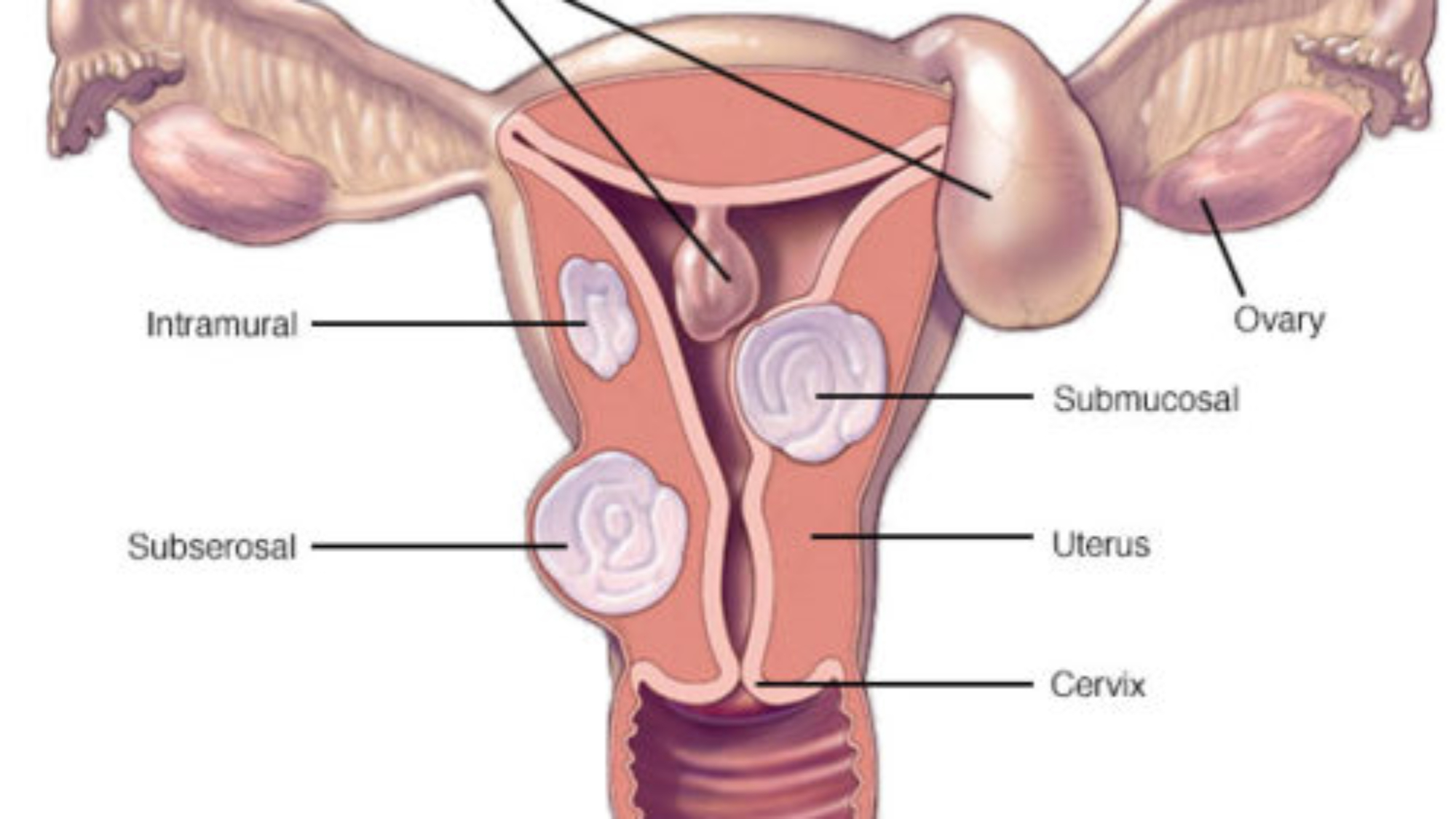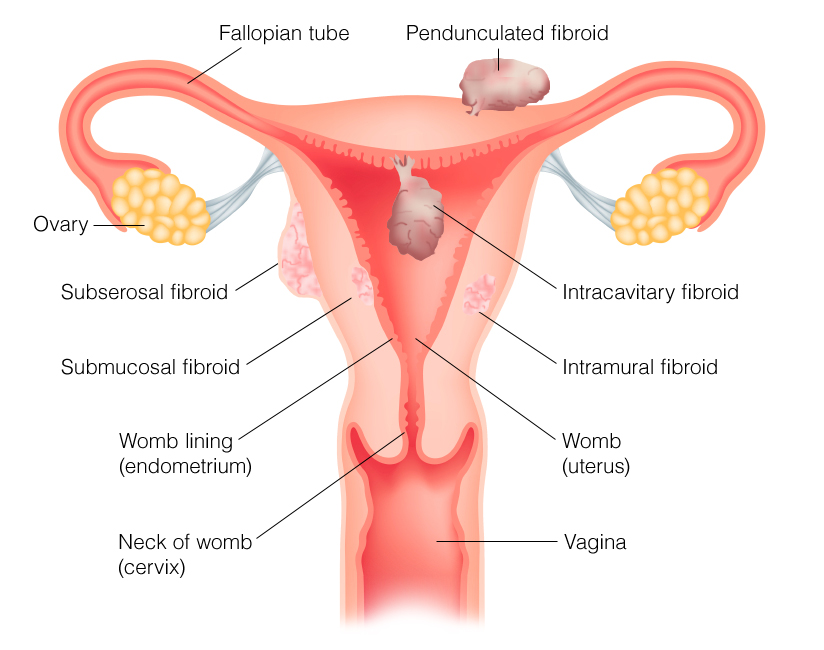You and Uterine Fibroids
A guide for women who have been diagnosed with uterine fibroids.
- Uterine Fibroids are unusual growths found in the muscle wall of the uterus (medical term for your womb)
- This can cause heavy and painful periods and have a negative impact on your day to day life.
- Respond to changes in progesterone level (a type of natural hormone)
What are uterine fibroids?
Uterine fibroids are unusual growths found in the muscle of the uterus (the medical term for your womb). They grow very slowly and over time can become very large.
When this happens, they can cause pain and discomfort and (unsurprisingly) have a negative impact on your day to day life. Sometimes you may hear them referred to as ‘tumors’, which may sound alarming, but rest assured uterine fibroids are not a type of cancer. ‘Tumor’ simply means an unexpected growth.
How common are they?
Uterine fibroids are very common: more than 40% of women will develop them at some point in their lives. Typically, they affect women of childbearing age (usually over the age of 35). However, the causes of uterine fibroids are not fully understood.
What we do know is that they respond to changes in progesterone levels in your body – a naturally occurring hormone. Treatments that target progesterone, like selective progesterone-receptor modulators (SPRMs), can help control the growth of uterine fibroids and the symptoms that they can cause.
Are there different types of uterine fibroids?
There are many different types of uterine fibroids. Each type is found in a different location in the uterus, and a combination of different types can also occur:
- Intramural fibroids are found within the wall of the uterus and are the most common type.
- Subserosal fibroids are found on the outer wall of the uterus. Sometimes they are attached by a thin stalk called a peduncle.* These types are called ‘pedunculated subserosal fibroids’ and can cause a lot of pain because they can twist around or compress other organs in the stomach.
- Submucosal fibroids grow on the inner wall of the uterus (endometrium). Because they push into the uterus, they can cause it to change in shape and size. Submucosal fibroids can also be pedunculated.
- Cervical fibroids are found in the ‘neck’ (cervix) of the uterus.
- Intraligamentous fibroids grow on the ligaments that hold the uterus in place.
What are the symptoms?
Uterine fibroids may cause symptoms such as:
- Heavy, painful periods that last a long time
- Anemia (a lack of red blood cells) due to heavy periods, causing extreme tiredness
- Bleeding between periods
- A feeling of pressure in the bladder and stomach
- Needing to go to the toilet more often than usual
- Discomfort while going to the toilet
- A visible increase in the size of the stomach
- Constipation
- Pain during sex
- Complications during pregnancy, such as an increased risk of miscarriage and/or problems during labor
- Difficulty getting pregnant
- General fatigue
What types of treatments can be used to treat fibroids?
There’s no single best approach to uterine fibroid treatment— many treatment options exist. If you have symptoms, talk with your doctor about options for symptom relief.
1) Medications
Medications for uterine fibroids target hormones that regulate your menstrual cycle, treating symptoms such as heavy menstrual bleeding and pelvic pressure.
They don’t eliminate fibroids but may shrink them. These medications include:
• Gonadotropin-releasing hormone (GnRH) agonists
Medications called GnRH agonists treat fibroids by blocking the production of estrogen and progesterone, putting you into a temporary postmenopausal state. As a result, menstruation stops, fibroids shrink and anemia often improves. Your doctor may prescribe a GnRH agonist to shrink the size of your fibroids before a planned surgery. Many women have significant hot flushes while using GnRH agonists. GnRH agonists are typically used for no more than three to six months because of symptoms.
Selective progesterone receptor modulators (SPRMs)
SPRMs are a new class of oral medications that significantly decreases the size of the fibroids found in your uterus. They also significantly reduce the excessive menstrual bleeding which leads to quality of life being restored.
Progestin-releasing intrauterine device (IUD)
A progestin-releasing IUD can relieve heavy bleeding caused by fibroids. A progestin-releasing IUD provides symptom relief only and doesn’t shrink fibroids or make them disappear.
2) Non-invasive procedure
MRI-guided focused ultrasound surgery (FUS) is:
A non-invasive treatment option for uterine fibroids that preserves your uterus, requires no incision and is done on an outpatient basis.
Performed while you’re inside an MRI scanner equipped with a high-energy ultrasound transducer for treatment. The images give your doctor the precise location of the uterine fibroids. When the location of the fibroid is targeted, the ultrasound transducer focuses sound waves (sonications) into the fibroid to heat and destroy small areas of fibroid tissue.
Newer technology, so researchers are learning more about the long-term safety and effectiveness. But so far data collected show that FUS for uterine fibroids is safe and effective.
3) Minimally invasive procedures
(Certain procedures can destroy uterine fibroids without actually removing them through surgery. They include)
Uterine artery embolization
Small particles (embolic agents) are injected into the arteries supplying the uterus, cutting off blood flow to fibroids, causing them to shrink and die. This technique can be effective in shrinking fibroids and relieving the symptoms they cause. Complications may occur if the blood supply to your ovaries or other organs is compromised.
Myolysis
In this laparoscopic procedure, an electric current or laser destroys the fibroids and shrinks the blood vessels that feed them. A similar procedure called cryomyolysis freezes the fibroids. Myolysis is not used often. Another version of this procedure, radiofrequency ablation, is being studied.
Laparoscopic or robotic myomectomy
In a myomectomy, your doctor removes the fibroids, leaving the uterus in place. If the fibroids are small and few in number, you and your doctor may consider for a laparoscopic or robotic procedure, which uses slender instruments inserted through small incisions in your abdomen to remove the fibroids from your uterus. Your doctor views your abdominal area on a monitor using a small camera attached to one of the instruments. Robotic myomectomy gives your doctor a magnified, 3-D view of your uterus, offering more precision, flexibility, and dexterity than is possible using some other techniques.
Hysteroscopic myomectomy
This procedure may be an option if the fibroids are contained inside the uterus (submucosal). Your doctor accesses and removes fibroids using instruments inserted through your vagina and cervix into your uterus.
Endometrial ablation and resection of submucosal fibroids.
This treatment, performed with a specialized instrument inserted into your uterus, uses heat, microwave energy, hot water or electric current to destroy the lining of your uterus, either ending menstruation or reducing your menstrual flow. Typically, endometrial ablation is effective in stopping abnormal bleeding. Submucosal fibroids can be removed at the time of hysteroscopy for endometrial ablation, but this doesn’t affect fibroids outside the interior lining of the uterus.
Traditional Surgical Procedures
Options for traditional surgical procedures include:
Abdominal myomectomy
If you have multiple fibroids, very large fibroids or very deep fibroids, your doctor may use an open abdominal surgical procedure to remove the fibroids. Many women who are told that hysterectomy is their only option can have an abdominal myomectomy instead.
Hysterectomy
This surgery – the removal of the uterus – remains the only proven permanent solution for uterine fibroids. But hysterectomy is a major surgery. It ends your ability to bear children. And if you also elect to have your ovaries removed, it brings on menopause and the question of whether you’ll take hormone replacement therapy. Most women with uterine fibroids can choose to keep their ovaries.
If you have any of the symptoms mentioned above, please speak to Dr.Gan Kam Ling, Obstetrician and Gynaecologist at Gleneagles Penang. You can book your appointment to see Dr. Gan here.




Add a Comment